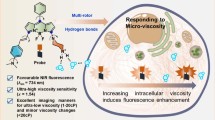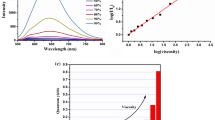Abstract
Intracellular viscosity is closely related to a series of biological processes and could be a biomarker for various diseases. Herein, we reported a deep-red emission viscosity probe ACI, which showed a turn-on fluorescence effect with excellent selectivity encountering high viscous medium. To assure the practical biological application, ACI demonstrated not only a long wavelength emission at 634 nm but also a long wavelength excitation at 566 nm, which were crucial to afford deeper penetration depth and higher sensitivity in bioimaging. The photophysical properties and viscosity recognition mechanism of the probe were carefully discussed here. Theoretical calculations furtherly confirmed that high viscous medium could inhibit the twisted intramolecular charge transfer (TICT) process of the probe which quenched the fluorescence in low viscous media, and restore the emission. More importantly, it was successfully applied to visualize the viscosity in living cells.

Graphical abstract






Similar content being viewed by others
References
Yang Z, He Y, Lee JH, Park N, Suh M, Chae WS, et al. A self-calibrating bipartite viscosity sensor for mitochondria. J Am Chem Soc. 2013;135(24):9181–5.
Chen B, Li C, Zhang J, Kan J, Jiang T, Zhou J, et al. Sensing and imaging of mitochondrial viscosity in living cells using a red fluorescent probe with a long lifetime. Chem Commun. 2019;55(51):7410–3.
Zhu H, Fan J, Li M, Cao J, Wang J, Peng X. A "distorted-BODIPY"-based fluorescent probe for imaging of cellular viscosity in live cells. Chem Eur J. 2014;20(16):4691–6.
Ow YP, Green DR, Hao Z, Mak TW. Cytochrome c: functions beyond respiration. Nat Rev Mol Cell Biol. 2008;9(7):532–42.
Chen W, Gao C, Liu X, Liu F, Wang F, Tang LJ, et al. Engineering organelle-specific molecular viscosimeters using aggregation-induced emission luminogens for live cell imaging. Anal Chem. 2018;90(15):8736–41.
Chen T, Chen Z, Liu R, Zheng S. A NIR fluorescent probe for detection of viscosity and lysosome imaging in live cells. Org Biomol Chem. 2019;17(26):6398–403.
Gao S, Ma Y, Lin W. A deep-red emission fluorescent probe for detection of viscosity in living cells and mice. Anal Methods. 2019;11(20):2626–9.
Li X, Gao X, Shi W, Ma H. Design strategies for water-soluble small molecular chromogenic and fluorogenic probes. Chem Rev. 2014;114(1):590–659.
Kim HM, Cho BR. Small-molecule two-photon probes for bioimaging applications. Chem Rev. 2015;115(11):5014–55.
Chen D, Yang J, Dai J, Lou X, Zhong C, Yu X, et al. A low background D–A–D type fluorescent probe for imaging of biothiols in living cells. J Mater Chem B. 2018;6(32):5248–55.
Chen D, Long Z, Dang Y, Chen L. A novel fluorescent probe with red emission and a large Stokes shift for selective imaging of endogenous cysteine in living cells. Analyst. 2018;143(23):5779–84.
Jin Y, Tian X, Jin L, Cui Y, Liu T, Yu Z, et al. Highly specific near-infrared fluorescent probe for the real-time detection of beta-glucuronidase in various living cells and animals. Anal Chem. 2018;90(5):3276–83.
Long Z, Chen L, Dang Y, Chen D, Lou X, Xia F. An ultralow concentration of two-photon fluorescent probe for rapid and selective detection of lysosomal cysteine in living cells. Talanta. 2019;204:762–8.
Zhang P, Wang H, Hong Y, Yu M, Zeng R, Long Y, et al. Selective visualization of endogenous hypochlorous acid in zebrafish during lipopolysaccharide-induced acute liver injury using a polymer micelles-based ratiometric fluorescent probe. Biosens Bioelectron. 2018;99:318–24.
Zhang P, Wang H, Zhang D, Zeng X, Zeng R, Xiao L, et al. Two-photon fluorescent probe for lysosome-targetable hypochlorous acid detection within living cells. Sensors Actuators B Chem. 2018;255:2223–31.
Liu F, Wu T, Cao J, Cui S, Yang Z, Qiang X, et al. Ratiometric detection of viscosity using a two-photon fluorescent sensor. Chem Eur J. 2013;19(5):1548–53.
Panettieri S, Silverman JR, Nifosi R, Signore G, Bizzarri R, John G. Unique photophysical behavior of coumarin-based viscosity probes during molecular self-assembly. Acs Omega. 2019;4(3):4785–92.
Dai X, Dong B, Ren M, Lin W. Unique D–π–A–π–D type fluorescent probes for the two-photon imaging of intracellular viscosity. J Mater Chem B. 2018;6(3):381–5.
Cao X, Liu J, Hong P, Li G, Hao C. Styrylcyanine-based fluorescent probes with red-emission and large Stokes shift for the detection of viscosity. J Photochem Photobiol A Chem. 2017;346:444–51.
Suhling K. Twist and probe-fluorescent molecular rotors image Escherichia coli cell membrane viscosity. Biophys J. 2016;111(7):1337–8.
Su D, Teoh CL, Gao N, Xu QH, Chang YT. A simple BODIPY-based viscosity probe for imaging of cellular viscosity in live cells. Sensors. 2016;16(9):1397.
Peng M, Yin J, Lin W. A two-photon fluorescent probe for detecting lipid droplet viscosity in living cells and zebra fish. New J Chem. 2018;42(23):18521–5.
Sun W, Cui J-X, Ma L-L, Lu Z-L, Gong B, He L, et al. Imaging nucleus viscosity and G-quadruplex DNA in living cells using a nucleus-targeting two-photon fluorescent probe. Analyst. 2018;143(23):5799–804.
Sun W, Shi Y-D, Ding A-X, Tan Z-L, Chen H, Liu R, et al. Imaging viscosity and peroxynitrite by a mitochondria-targeting two-photon ratiometric fluorescent probe. Sensors Actuators B Chem. 2018;276:238–46.
Yin J, Peng M, Lin W. Visualization of mitochondrial viscosity in inflammation, fatty liver, and cancer living mice by a robust fluorescent probe. Anal Chem. 2019;91(13):8415–21.
Li X, Zhao R, Wang Y, Huang C. A new GFP fluorophore-based probe for lysosome labelling and tracing lysosomal viscosity in live cells. J Mater Chem B. 2018;6(41):6592–8.
Li LL, Li K, Li MY, Shi L, Liu YH, Zhang H, et al. BODIPY-based two-photon fluorescent probe for real-time monitoring of lysosomal viscosity with fluorescence lifetime imaging microscopy. Anal Chem. 2018;90(9):5873–8.
Jiang N, Fan J, Zhang S, Wu T, Wang J, Gao P, et al. Dual mode monitoring probe for mitochondrial viscosity in single cell. Sensors Actuators B Chem. 2014;190:685–93.
Guo R, Yin J, Ma Y, Li G, Wang Q, Lin W. A novel NIR probe for detection of viscosity in cellular lipid droplets, zebra fishes and living mice. Sensors Actuators B Chem. 2018;271:321–8.
Gadda G, Sobrado P. Kinetic solvent viscosity effects as probes for studying the mechanisms of enzyme action. Biochemistry. 2018;57(25):3445–53.
Xochitiotzi-Flores E, Jiménez-Sánchez A, García-Ortega H, Sánchez-Puig N, Romero-Ávila M, Santillan R, et al. Optical properties of two fluorene derived BODIPY molecular rotors as fluorescent ratiometric viscosity probes. New J Chem. 2016;40(5):4500–12.
Baek Y, Park SJ, Zhou X, Kim G, Kim HM, Yoon J. A viscosity sensitive fluorescent dye for real-time monitoring of mitochondria transport in neurons. Biosens Bioelectron. 2016;86:885–91.
Li SJ, Li YF, Liu HW, Zhou DY, Jiang WL, Ou-Yang J, et al. A dual-response fluorescent probe for the detection of viscosity and H2S and its application in studying their cross-talk influence in mitochondria. Anal Chem. 2018;90(15):9418–25.
Tan H-y, Y-t Q, Sun H, J-w Y, Zhang L. A lysosome-targeting dual-functional fluorescent probe for imaging intracellular viscosity and beta-amyloid. Chem Commun. 2019;55(18):2688–91.
Wang H, Fang B, Xiao L, Li D, Zhou L, Kong L, et al. A water-soluble “turn-on” fluorescent probe for specifically imaging mitochondria viscosity in living cells. Spectrochim Acta Part A. 2018;203:127–31.
Wu Y, Shu W, Zeng C, Guo B, Shi J, Jing J, et al. A mitochondria targetable and viscosity sensitive fluorescent probe and its applications for distinguishing cancerous cells. Dyes Pigments. 2019;168:134–9.
Zhang G, Ni Y, Zhang D, Li H, Wang N, Yu C, et al. Rational design of NIR fluorescence probes for sensitive detection of viscosity in living cells. Spectrochim Acta A. 2019;214:339–47.
Zhang Y, Li Z, Hu W, Liu Z. A mitochondrial-targeting near-infrared fluorescent probe for visualizing and monitoring viscosity in live cells and tissues. Anal Chem. 2019;91(15):10302–9.
Ma Y, Zhao Y, Guo R, Zhu L, Lin W. A near-infrared emission fluorescent probe with multi-rotatable moieties for highly sensitive detection of mitochondrial viscosity in an inflammatory cell model. J Mater Chem B. 2018;6(39):6212–6.
Zhou X, Lv X, Hao J, Liu D, Guo W. Coumarin–indanedione conjugate as a doubly activated Michael addition type probe for the colorimetric and ratiometric fluorescent detection of cyanide. Dyes Pigments. 2012;95(2):168–73.
Grimme S, Ehrlich S, Goerigk L. Effect of the damping function in dispersion corrected density functional theory. J Comput Chem. 2011;32(7):1456–65.
Lu T, Chen F. Multiwfn: a multifunctional wavefunction analyzer. J Comput Chem. 2012;33(5):580–92.
Jiang X, Yu Y, Chen J, Zhao M, Chen H, Song X, et al. Quantitative imaging of glutathione in live cells using a reversible reaction-based ratiometric fluorescent probe. ACS Chem Biol. 2015;10(3):864–74.
Kim WY, Shi H, Jung HS, Cho D, Verwilst P, Lee JY, et al. Coumarin-decorated Schiff base hydrolysis as an efficient driving force for the fluorescence detection of water in organic solvents. Chem Commun. 2016;52(56):8675–8.
Luo J, Xie Z, Lam JW, Cheng L, Chen H, Qiu C, et al. Aggregation-induced emission of 1-methyl-1,2,3,4,5-pentaphenylsilole. Chem Commun. 2001;18:1740–1.
Acknowledgments
The DFT calculations in this paper have been done on the supercomputing system in the Supercomputing Center of Wuhan University. The authors would like to thank Shiyanjia Lab (www.shiyanjia.com) for the support of cell imaging.
Funding
This work was financially supported by the National Natural Science Foundation of China (Nos. 51703171, 51873160), and Science Foundation of Wuhan Institute of Technology (No. K201754).
Author information
Authors and Affiliations
Corresponding authors
Ethics declarations
Conflict of interest
The authors declare that they have no conflicts of interest.
Additional information
Publisher’s note
Springer Nature remains neutral with regard to jurisdictional claims in published maps and institutional affiliations.
Electronic supplementary material
ESM 1
(PDF 776 kb)
Rights and permissions
About this article
Cite this article
Chen, L., Feng, Y., Dang, Y. et al. A deep-red emission fluorescent probe with long wavelength absorption for viscosity detection and live cell imaging. Anal Bioanal Chem 412, 7819–7826 (2020). https://doi.org/10.1007/s00216-020-02911-2
Received:
Revised:
Accepted:
Published:
Issue Date:
DOI: https://doi.org/10.1007/s00216-020-02911-2




